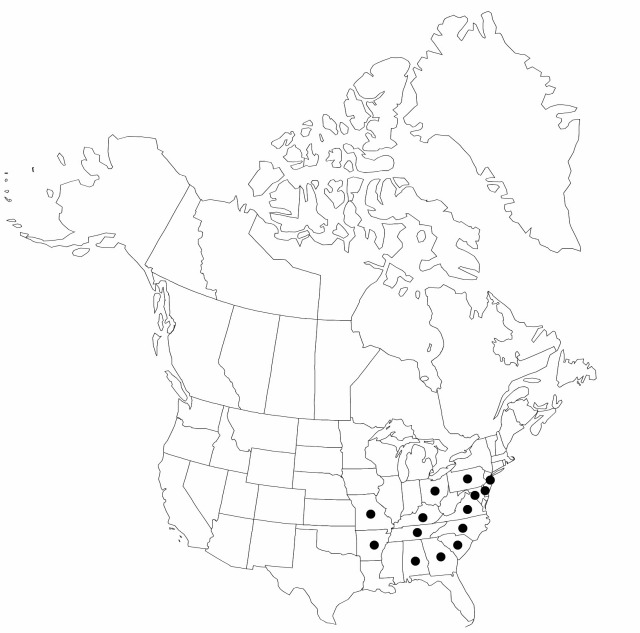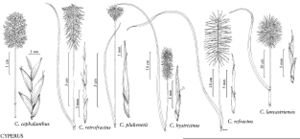Difference between revisions of "Cyperus retrofractus"
in J. Carey, Carices North. U.S., 519. 1847.
FNA>Volume Importer |
FNA>Volume Importer |
||
| Line 15: | Line 15: | ||
|name=Cyperus dipsaciformis | |name=Cyperus dipsaciformis | ||
|authority=Fernald | |authority=Fernald | ||
| − | }}{{Treatment/ID/Synonym | + | }} {{Treatment/ID/Synonym |
|name=Cyperus retrofractus var. dipsaciformis | |name=Cyperus retrofractus var. dipsaciformis | ||
|authority=(Fernald) Kükenthal | |authority=(Fernald) Kükenthal | ||
| − | }}{{Treatment/ID/Synonym | + | }} {{Treatment/ID/Synonym |
|name=Mariscus retrofractus | |name=Mariscus retrofractus | ||
|authority=unknown | |authority=unknown | ||
| Line 36: | Line 36: | ||
|elevation=0–300 m | |elevation=0–300 m | ||
|distribution=Ala.;Ark.;Del.;D.C.;Ga.;Ky.;Mo.;N.J.;N.C.;Ohio;Pa.;S.C.;Tenn.;Va. | |distribution=Ala.;Ark.;Del.;D.C.;Ga.;Ky.;Mo.;N.J.;N.C.;Ohio;Pa.;S.C.;Tenn.;Va. | ||
| − | |discussion=<p>For information concerning nomenclature of Cyperus retrofractus, see J. R. Carter and C. E. Jarvis (1986).</p> | + | |discussion=<p>For information concerning nomenclature of <i>Cyperus retrofractus</i>, see J. R. Carter and C. E. Jarvis (1986).</p> |
|tables= | |tables= | ||
|references= | |references= | ||
| Line 60: | Line 60: | ||
|publication year=1847 | |publication year=1847 | ||
|special status= | |special status= | ||
| − | |source xml=https://jpend@bitbucket.org/aafc-mbb/fna-data-curation.git/src/ | + | |source xml=https://jpend@bitbucket.org/aafc-mbb/fna-data-curation.git/src/8f726806613d60c220dc4493de13607dd3150896/coarse_grained_fna_xml/V23/V23_307.xml |
|genus=Cyperus | |genus=Cyperus | ||
|subgenus=Cyperus subg. Cyperus | |subgenus=Cyperus subg. Cyperus | ||
Revision as of 16:07, 18 September 2019
Herbs, perennial, cespitose. Culms with cormlike bases, sharply trigonous, 25–90 cm, glabrous proximally, minutely scabridulous distally. Leaves V-shaped, 14–40 cm × 3.5–8 mm, (pubescent on adaxial side of midrib). Inflorescences: spikes loose, obtrulloid to obdeltoid (broadest near apex, nearly as long as wide), 20–28(–34) × (12–)15–30 mm; rays 4–13, (1–)4–24 cm (longest ray shorter than bracts), glabrous; bracts 3–12, ascending at 30–45°, flat, 3–25 cm × 3–7 mm; rachilla persistent, wings 0.4–0.6 mm wide, covering 3/4 of mature achene. Spikelets 30–50, proximal one reflexed, distal ones divaricate, linear-lanceoloid, ± terete, (6.5–) 8–10(–17) × 0.5–0.7 mm; floral scales persistent, 3–6(–8), appressed, stramineous (suffused with reddish purple), 4–5-ribbed laterally, ovate-lanceolate, (4–)4.4–4.9(–5.4) × 1.3–1.5 mm; terminal scale not spinose, apex straight, excurved mucronate, or cuspidate. Flowers: anthers 0.7–1.2 mm; styles 1.5–2 mm; stigmas 2–2.5 mm. Achenes brown to brownish black, narrowly oblong, (2.2–)2.5–3 × 0.6–0.7 mm, base cuneate, apex obtuse, apiculate, surfaces puncticulate.
Phenology: Fruiting summer.
Habitat: Roadsides, pastures, disturbed sites in sandy or clayey soils
Elevation: 0–300 m
Distribution

Ala., Ark., Del., D.C., Ga., Ky., Mo., N.J., N.C., Ohio, Pa., S.C., Tenn., Va.
Discussion
For information concerning nomenclature of Cyperus retrofractus, see J. R. Carter and C. E. Jarvis (1986).
Selected References
None.
